Guinea Pig Husbandry
Kathryn G. Torres, RVT, VTS (Clinical Practice/Exotics), Pet Emergency & Specialty Center, La Mesa, California
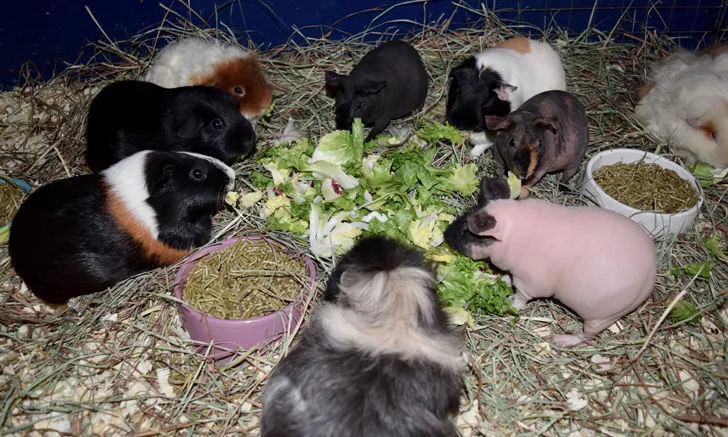
A 2012 census of US pet ownership identified guinea pigs (Cavia porcellus) as the second most common companion small rodent.1 (See Figure 1.) Guinea pigs are docile, social animals that enjoy interaction with their caretakers, and their husbandry needs are relatively simple.2 However, guinea pigs have specific dietary and housing needs, and improper at-home care can result in illness or injury. The veterinary team should be familiar with guinea pig husbandry to ensure these small rodents receive appropriate veterinary care.3
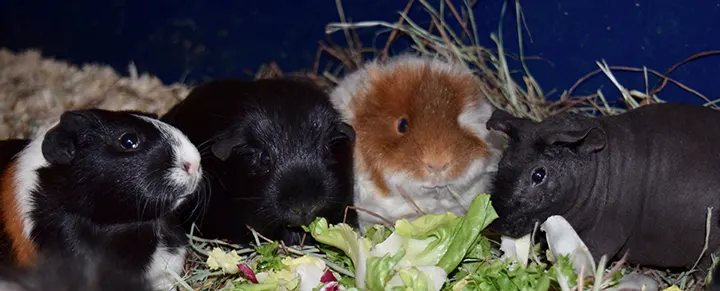
Guinea pigs are social animals that live happily in groups. Photos courtesy of Kathryn G. Torres, RVT, VTS (Clinical Practice/Exotics)
The American Cavy Breeders Association (ACBA) recognizes 13 domestic guinea pig breeds.4 The original core breeds accepted by the ACBA for show, as well as for research and as pets, include the English or American shorthair, rough-coated Abyssinian, and long-haired Peruvian.3 In 2010, some US pet stores began selling a giant breed of guinea pig imported from Peru. They are the result of selective breeding of domesticated guinea pigs to create an economical meat source for impoverished regions of Peru.
New Giant Guinea Pig Breed
This giant breed, Cuys criollos mejorados, differs from standard guinea pigs in many ways.
These guinea pigs are larger, stronger, and more nervous than the standard breeds typically seen in US veterinary practices.5
“Cuys” (pronounced “coo-ees”) are considered difficult pets, and owners and the veterinary team must understand the special concerns this giant breed presents (eg, they do not tame easily and often remain frightened by their human caretakers).
They grow to be twice as large as the typical pet guinea pig, weighing between 1.8 kg and 3.6 kg.6
Attempts to pick up or handle these animals often results in a fright response, characterized by powerful speed and strength to escape; if such a response is not anticipated, an inexperienced owner or veterinary team member may inadvertently harm the guinea pig or themselves.
Cuys are also known to jump, thus requiring special caging to keep them safe.
Owners need to be aware of this giant breed’s special needs when considering adoption or purchase. When these animals are presented to the veterinary practice, team members must understand the cuy’s fear response and know how to safely catch, handle, and restrain for examination and treatments.5,6
Overview
A guinea pig’s average lifespan is 5 to 6 years. Adult guinea pigs weigh between 0.7 kg and 1.2 kg, and male guinea pigs typically are larger than females. Guinea pigs have short, stocky bodies and short legs, and their thoracic cavity is small relative to body size, which may increase susceptibility to respiratory conditions.3 Guinea pigs are strictly herbivorous, hindgut fermenters with a large cecum and colon, and they can only acquire vitamin C (ascorbic acid) through diet. Guinea pigs have open-rooted, elodont teeth with a dental formula of 4 incisors and 16 cheek teeth.7 (See Figure 2.)
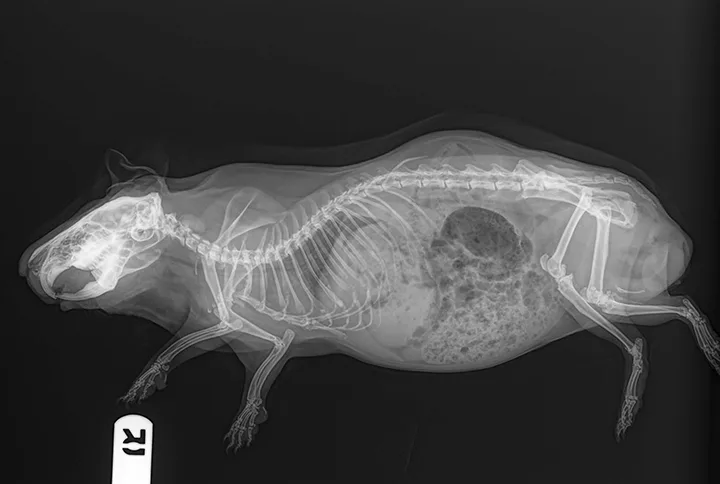
Lateral radiograph of a guinea pig. Radiograph courtesy of Pet Emergency & Specialty Center, La Mesa, California
Housing
Guinea pigs produce abundant feces, and wire cages that allow air to circulate freely help reduce odors and ammonia buildup from waste products. Cages with solid bottoms minimize injury to feet and limbs. No cage top is required because guinea pigs typically do not jump or climb, but guinea pigs must be protected from other household pets or unwanted handling.8 (See Figure 3.) Cage sides should be at least 10 inches tall, and ramps and multilevel cages are not recommended. With heavy bodies, short legs, and little sense of an edge,8 guinea pigs may easily fall from a ramp or raised floor and injure themselves.9
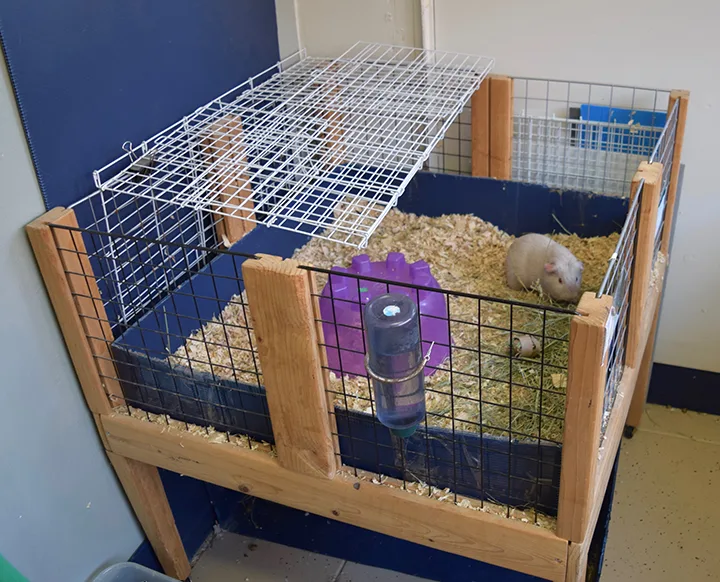
A wire cage with a solid bottom provides a safe, easy-to-clean environment.
Enclosed glass or plastic are inappropriate for housing because of inhibited air circulation resulting in increased ambient temperature, especially when placed near windows or in direct light. Ideal environmental temperatures range from 64˚F to 79˚F, with 70˚F recommended. Guinea pigs are more tolerant of cooler temperatures than warm temperatures, especially when high humidity is a factor.10 Drafty areas should be avoided.
Guinea pigs demonstrate thigmotaxis, a tendency to remain close to the cage perimeter, and they do not freely cross the middle of an enclosure.11 This wall-hugging behavior is best served by rectangular-shaped caging. Providing PVC pipes and multiple hiding houses help subdivide the open space. (See Figure 4.) In a laboratory setting in the United States, housing must meet a minimum floor space requirement of 656.5 cm2 for a single guinea pig.3 For pet guinea pigs, at least twice as much floor space (ie, 1872 cm2 per animal) is recommended.2,3

Multiple hiding houses help subdivide the rectangular space of a cage and provide safe places to rest.
Bedding
Guinea pigs are prey animals and prefer to burrow and hide when resting (see Figure 5), and cage items and substrate should accommodate this natural behavior. Appropriate bedding includes hardwood aspen shavings and commercial recycled wood pulp fiber products. Aromatic wood shavings (eg, pine, cedar) and products that grow mold when wet (eg, corncob bedding) should be avoided because they can cause respiratory illness.2 Fleece bedding placed over an absorbent material (eg, 100% cotton bath towels, furniture pads, mattress pads) offers a softer option.12 Animals housed in wire-bottom caging without solid bedding for support are prone to limb injuries.3,13

Bedding that allows burrowing supports the natural instinct of guinea pigs to hide from predators.
Cages should be spot-cleaned at least every other day, and any wet bedding, wet hay, and feces should be removed. A thorough cage cleaning and rinsing should be performed weekly using hot water and a disinfectant (eg, diluted bleach, white vinegar). Feces, urine, food, and water all soil the cage, so fresh bedding must be replaced regularly.10,12,14
Diet
Guinea pigs are born precocial and can eat solid food within hours following birth. Imprinting on food items occurs at an early age and adults may refuse dietary changes.8 To prevent food preference development, young guinea pigs should be offered a variety of appropriate food items in their diet.
A high-fiber, low-starch diet maintains motility of the GI tract and prevents fermentation dysbiosis during digestion.15 High-fiber grass hays (eg, timothy hay, orchard grass) should be offered to adult guinea pigs ad libitum. Alfalfa, a high-fiber grass hay rich in protein and calcium, is suitable only for young and growing guinea pigs (ie, less than 6 months of age) or guinea pigs that are pregnant or lactating.12 (See Figure 6.)
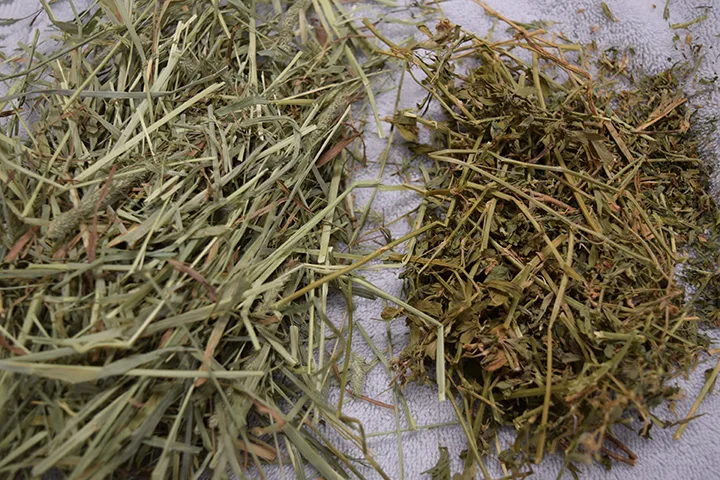
High-fiber grass hays (eg, timothy [left] and alfalfa [right]) are appropriate feed choices.
Commercial timothy hay-based pelleted diets made specifically for guinea pigs may be offered to adults, whereas alfalfa-based pellets should be fed only to young and developing animals or those who are pregnant or lactating. Adult feed generally contains 18% to 20% crude protein and 9% to 18% crude fiber.13 Some commercial pellet diets include starches and simple carbohydrates (eg, corn, dried fruit, seeds). Guinea pigs may love these added treats, but the sugar they contain can upset the natural balance of bacteria in the GI tract and provide unnecessary calories.
A diet rich in vitamin C helps prevent scurvy. The recommended daily allowance of vitamin C is 7 to 10 mg/kg/d for healthy guinea pigs and 20 to 30 mg/kg/d for animals with vitamin C deficiency.3,13 Guinea pig pellets are manufactured with vitamin C, but the ascorbic acid begins to degrade 90 days post mill date,3 and additional supplementation is recommended. Vitamin C supplements can be added to water, but vitamin C denatures quickly and may give water a bad taste. Liquid vitamin C supplements should be administered orally for best results.
Fresh produce is a good source of fiber and vitamins, especially vitamin C, and should be offered daily. (See Figure 7.) The high oxalate concentration in dark leafy greens (eg, kale, spinach) may contribute to urinary calculi formation and should be offered only in small amounts.
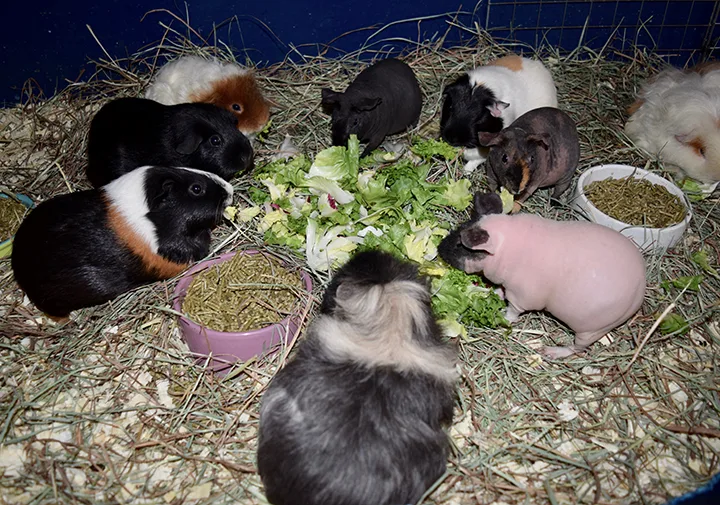
Fresh produce is a good source of vitamin C.
Fresh water must be offered at all times and can be provided in dishes or sipper bottles that attach to the side of the cage. (See Figure 8.) Guinea pigs retain chewed food in their mouths and may spit it into their water dish or the tip of the bottle sipper when drinking. Water containers should be thoroughly cleaned and filled daily.
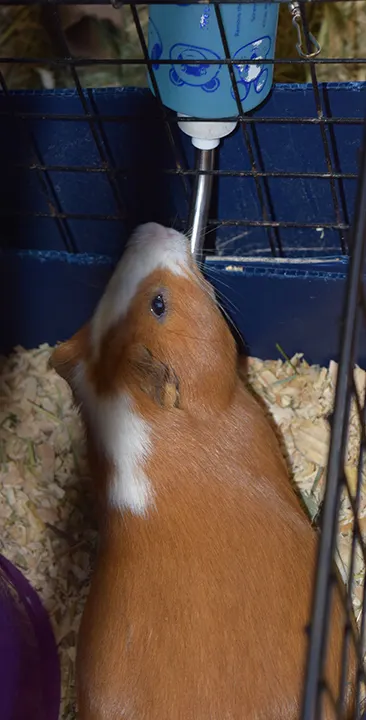
Guinea pigs will drink readily from a sipper water bottle attached to the side of the cage.
Grass hay helps keep teeth at a proper length. Small, untreated blocks of wood may also be offered as appropriate chew toys.
Veterinary Care
Guinea pigs do not require vaccinations, but they should undergo an annual veterinary examination. During these check-ups, husbandry and diet are reviewed to ensure proper home care continues for the life of the guinea pig. Some common medical concerns that can be related to husbandry and diet include dermatologic, dental, respiratory, and urinary diseases. These problems must be addressed by a veterinarian at the guinea pig’s first presentation.
Skin lesions or extreme scratching may be attributed to dermatophytosis or ectoparasites from contact with an infected environment or an individual animal. Dental disease resulting in malocclusion of cheek teeth often stems from improper diet and lack of vitamin C. Guinea pigs may show signs of difficulty chewing, reduced appetite or anorexia, and weight loss.3
Teeth that have become too long will impede a guinea pig’s ability to eat and should be trimmed by a veterinarian. Guinea pigs are highly susceptible to infection with Bordetella bronchiseptica, a bacteria that may be carried in asymptomatic pet rabbits and dogs. Direct exposure to infected animals can cause bacterial pneumonia in guinea pigs.10
Abnormal micturition and behavior changes (eg, lethargy, hunched posture) may be signs of urinary problems. Urolithiasis and subsequent urinary infections may be attributed to improper diet.3
Behavior
Guinea pigs are social animals and derive safety and support from other guinea pigs. (See Figure 9.) They live happily as bonded pairs or in groups; however, intact males should not be housed together, especially near female guinea pigs, as male pigs may become aggressive.8 Unfamiliar guinea pigs should be introduced gradually. If kept singly, guinea pigs must receive appropriate attention from their human caretakers and be provided a safe environment to thrive.
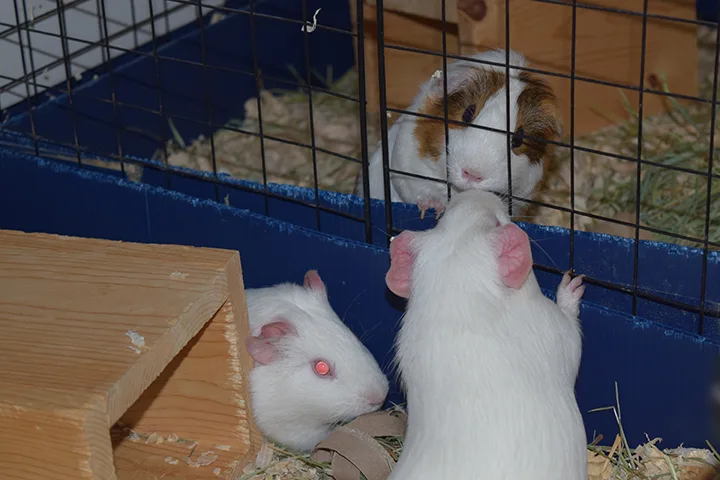
Guinea pigs derive safety and support from other guinea pigs.
Environmental enrichment allows animals to engage in normal, species-specific behaviors, thus reducing mental stress and improving physical health.16 Appropriate toys include items that guinea pigs can eat, hide under, run through, and push around. Ordinary items such as tissue boxes stuffed with hay and cardboard boxes with doorway cutouts provide low-cost enrichment. Commercial toys include plastic or willow balls.12
Conclusion
Guinea pig husbandry should address both the physical and mental needs of the pet guinea pig. A healthy guinea pig environment provides a safe shelter and substrate, an appropriate diet, and social stimulation and enrichment that encourage natural species behavior. Regular veterinary care from a team familiar with guinea pig husbandry helps ensure that these small rodents live happy, healthy lives.
Editor’s note: Guinea pigs depicted in figures are property of Wee Companions, Inc, a small animal adoption organization in San Diego, California.